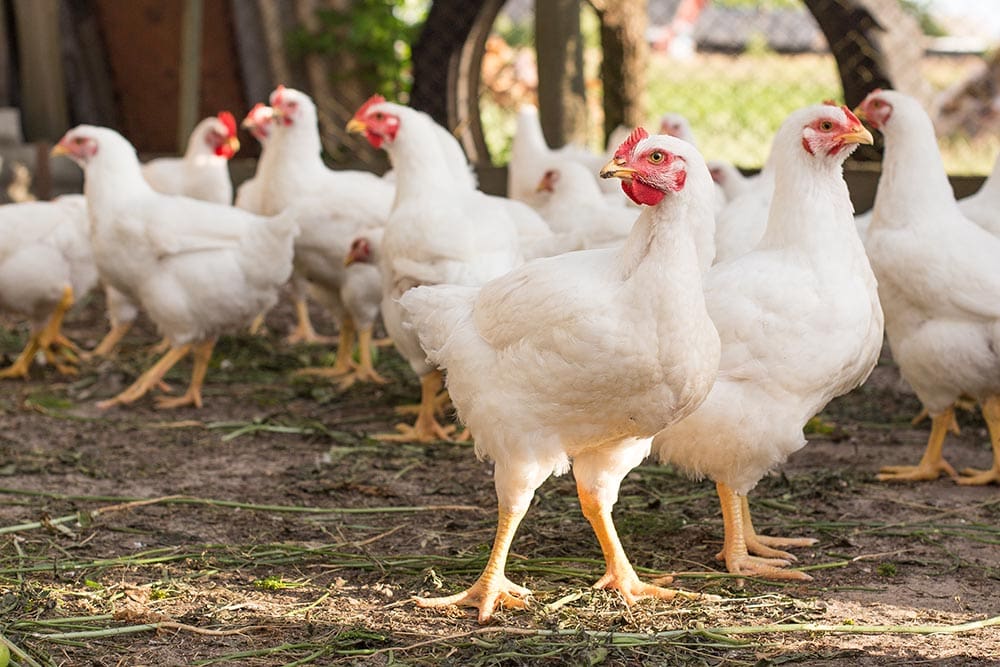Secrets In Successful Rearing Of Broiler Breeders

Table of Contents
What are the important factors in rearing productive broiler breeders? The time spent preparing for the new flock and the first seven to ten days after placement are the most critical time to promote the success of the flock. It is difficult with the lag in time between the rearing phase and the end of lay to pinpoint problems in rearing management that affected flock performance, but there is a direct relationship between the start the chicks get and how they perform during the lay cycle.
Let’s review the important points because *”A highly productive breeder flock begins in the rearing house.”
Sanitation
Clean the house thoroughly between flocks. Remove all litter. Wash the ceiling, sidewalls and equipment. Disinfect after the buildings are washed. Nothing should be left behind from the previous flock that has not been washed and sanitized. Clean the drinker lines with citric acid (or whatever is recommended by the manufacturer) to remove bacteria that may bind or kill vaccines introduced during the next flock. Remember to flush the lines before the next flock arrives. Some folks look at the sanitation of a poultry house as something extra, but there is no doubt that this is one of the most important investments that can be made to ensure your next flock is a success. Prevent problems by practicing good sanitation, rodent and fly control, and biosecurity during the life of the flock.
Be ready for the chicks. Equipment maintenance should be complete with all heaters, feeders, drinkers and fans serviced/repaired and in good working order. Readiness and reliability are critical in making it through the 20-week rearing phase without mechanical failures.
Temperature
Make sure the temperature (86 to 90°F) is right at bird height. In the coldest weather, run the heat long enough to make sure the floor is comfortable. If you feel any coolness when sitting on the litter, the birds will be chilled (with their body temperature of 106°F). Cold chicks don’t go to feed and will be picked up as mortality or starve-outs several days later.
Water
The water in the drinkers should be like cool bath water (80-85°F). If the water in the waterline is cold (below 55 F) before the chicks arrive, try turning the brooders/furnaces on earlier to prevent chilling the chicks as they get their first water. Dump the chicks at the drinkers. Provide plenty of watering space. If you are using nipple drinkers, have the light level high enough that the chicks can see and be attracted to the metal nipple (first 2-3 days). With low light levels some chicks do not find the nipple before they are dehydrated. In addition, the first day have the nipple drinker lines low so that the chicks actually run into the nipples. As the birds find the water, inch the lines up to encourage the birds to stretch their necks up for a drink and prevent water spilling onto the litter.
Feeds
Make sure the chicks eat the first day and several times each day until daily restricted feeding starts. Feeding is encouraged by freshen the feed available to the chicks (i.e. top dressing the feeder lids each day or twice a day) and running the automated feeder (sound attracts them). Start out with the feed and water together when the chicks arrive.
Slowly move the feeder lids toward the feed lines. As with the drinkers it is important that the chicks find their automated feeder and drinkers before the auxiliary drinkers or feeder lids are removed. They can be removed too early and they can stay too long. The objective is to get the breeder chicks eating the feed and drinking water as quickly as possible after arrival or mortality will be high. Breeder chicks have an extended processing time in the hatchery due to the number of services we requests. In addition, breeder chicks travel further than most broiler chicks, making it critical they consume water and feed within the first hour after placement. These chicks are expensive, so extra effort pays off in not only good livability but in excellent breeders down the road.
There is variation in all feed. However, pay particular attention to broiler breeder starter feed. If it does not look and smell right, it is probably not right. Call your field representative. This is not the time to have an error in the type or quality of the feed. One common problem is whole kernel corn getting into the starter feed. Baby chicks can’t eat these kernels, and they will miss some important nutrients, causing the flock to be off target body weight. One look in the feeder will show you the problem. Eventually, the birds will eat the corn, but it is weeks in being consumed.
Manage the feeder so that the feed is spread throughout the house. Adjust the gates or feeder run times so that feed makes it around the house or as far as possible to give the most feeder space per bird. If the feed only gets a few hundred feet each day, the most aggressive birds will consume a majority of the feed. Flock uniformity for body weight will be low and stay low because of the limited access to feed. Spread the feed all through the house to give all the birds access.
Feeding time should be consistent day to day. Birds are creatures of habit. They thrive on the same feed times and are comforted by the same routine each day. The birds will adapt to almost any daily pattern, but will perform best when they get the same pattern each day. Many old-time poultry people wear the same hat or the same color shirt and pants each day. I can’t attest to the value of this daily routine, but if you feed them on time each day you will reduce their stress levels and help them perform at their best.
Scales
Calibrate your scales or have a knowledgeable person do it. Many good flocks have been ruined by faulty equipment. The daily intake of the birds is important in getting them and keeping them on target body weight. They must receive the specified amount of feed &ndash not a little over or a little under. Probably the most difficult situation is the scale that gives variable results. Buy quality equipment and maintain it to give the birds the expected feed intake and improve consistency.
Vaccinations
Water vaccinations are among the most practiced method of delivering vaccines to birds. This is also the most abused method of vaccinating birds. What should be a quick and easy method of vaccine administration is often poorly executed resulting in low disease protection and/or low titres. All birds in the house must get a drink of the vaccine within a two-hours of vaccine dilution. The secret to successful water vaccination, is getting all the birds to drink the vaccine. Water deprive the birds the afternoon before or morning of the vaccination. Drain the water lines.
Timing, vaccine volume, and weather conditions should be considered. In most cases draining the water lines before the lights go out the day before vaccination will allow the birds to be thirst the next morning. However, if the weather is particularly hot (outside temperature of 95°F) birds will be thirsty due to weather conditions, and the time between removing the water and the start of vaccinations should be shortened. All the birds must get to the drinker when the vaccine is present. If the birds are too thirsty, the first ones at the drinker will consume all the vaccine. Walk the drinker lines and sidewall to insure that at all birds go to the drinker and move the more dominant birds away. Another important variable is the volume of vaccine to be used. The older the birds the greater the volume of vaccine needed to assure that all get the vaccine. Houses with chlorinated water must use a vaccine stabilizer or the chorine will kill live vaccines. Make sure that the stabilizer is in the water lines while the vaccine is present, and continue to run the stabilizer throughout the vaccination day.
A highly productive breeder flock begins in the rearing house.







